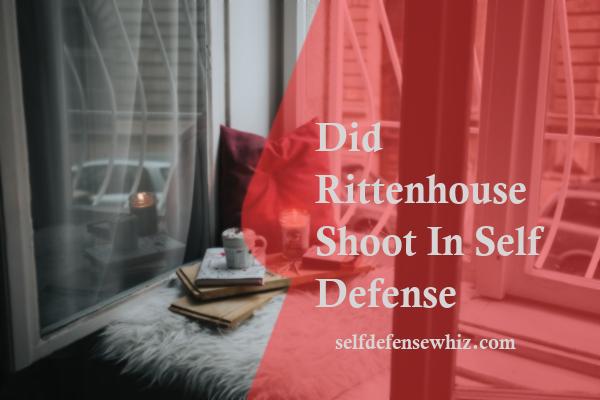How Can Rittenhouse Claim Self Defense
On the fateful night of August 25, 2020, a tragic incident unfolded during protests in Kenosha, Wisconsin, resulting in the deaths of two individuals and the injury of another. The central figure in this tumultuous event was Kyle Rittenhouse, a then 17-year-old who now faces multiple charges, including first-degree intentional homicide. Nonetheless, amidst the ensuing debates and controversies, the question arises: how can Rittenhouse claim self-defense? The **short answer** lies in his assertion that he was acting in self-defense as he encountered violent and aggressive confrontations during the protests.
How Can Rittenhouse Claim Self Defense
In order for Rittenhouse to claim self-defense, he must provide evidence to support the legal elements required for such a claim. Firstly, he must demonstrate that he had a reasonable belief that he was facing an imminent threat of death or serious bodily harm. Rittenhouse’s defense would likely argue that he was confronted by a hostile crowd and was being pursued and attacked by individuals who were armed or physically aggressive.
Secondly, Rittenhouse must prove that his use of force was necessary and proportionate to the perceived threat. His defense may argue that, given the circumstances, he reasonably believed that using a firearm was the only way to defend himself against those who posed a direct danger to his life. They may also emphasize that he had attempted to retreat or escape the situation before resorting to deadly force.
In addition to these elements, Rittenhouse’s defense may also highlight any evidence that supports his state of mind at the time of the incidents. This could include witness testimonies, video footage, or other forms of evidence that show his fear or anxiety during the events.
Pro-tips:
- Rittenhouse must demonstrate a reasonable belief of imminent threat to his life or serious bodily harm.
- He must establish that the use of force was necessary and proportionate.
- Emphasizing his attempt to retreat or escape may strengthen his claim.
- Presenting evidence of his state of mind during the incidents can be beneficial.
What Are The Legal Requirements For Claiming Self-Defense?
In order for Rittenhouse to claim self-defense, he would need to establish that he reasonably believed he was in imminent danger of death or serious bodily harm, and that the use of force was necessary to protect himself from that danger. This requires demonstrating that his perception of the threat was objectively reasonable under the circumstances. One key aspect of the self-defense argument in Rittenhouse’s case is the fact that he was armed with a firearm, which can significantly impact how a court assesses the reasonableness of his actions.
Rittenhouse’s defense team would likely argue that his decision to carry a weapon was lawful and rooted in the Second Amendment, as open carry is legal in Wisconsin for individuals over the age of 18. They might also emphasize the chaotic environment in which the events took place, highlighting that Rittenhouse was present at a highly charged and violent protest. By pointing out that he was targeted and attacked by multiple individuals, resulting in serious injuries, they could argue that he had no other choice but to use force in self-defense.
Additionally, Rittenhouse’s defense team might rely on video evidence and eyewitness testimony to establish that the individuals he shot were actively pursuing and attacking him, and that he reasonably believed they posed a threat to his life. The defense could argue that Rittenhouse’s actions were a reasonable response to the perceived danger he was facing, further bolstered by the fact that he did not shoot anyone until he was being directly confronted and physically assaulted.
However, it is important to note that whether Rittenhouse’s claim of self-defense succeeds will ultimately depend on how the court evaluates the evidence and interprets the applicable self-defense laws in Wisconsin. The burden will be on the defense to prove, by a preponderance of the evidence, that Rittenhouse’s use of force was justified under the circumstances.
Can Rittenhouse’S Actions Be Justified As Self-Defense?
Rittenhouse can potentially claim self-defense by arguing that he reasonably believed his life was in immediate danger and that his use of force was necessary to protect himself from imminent harm. In order to successfully establish self-defense, Rittenhouse’s defense team would need to demonstrate the following key elements:
Firstly, they would need to establish that Rittenhouse had a genuine and reasonable belief that he was facing an imminent threat of death or serious bodily harm. This can be supported by presenting evidence such as witness testimonies and video footage showing the chaotic and violent nature of the situation that night, including the numerous altercations and attacks that had occurred.
Secondly, Rittenhouse’s defense would need to show that he did not provoke or instigate the violence, but rather acted in response to an immediate threat. They might argue that he was exercising his right to be present and armed as a member of a citizen militia, and that any use of force was a direct result of the aggressive actions of others. They may also present evidence that Rittenhouse attempted to retreat or escape from the threatening situation before resorting to the use of deadly force.
Finally, Rittenhouse’s defense team would need to demonstrate that his use of force was proportionate and reasonable given the circumstances. They would argue that he reasonably believed shooting his attackers was necessary to protect his own life, given the perceived imminent threat they posed. This could include showing evidence of the attackers being armed or utilizing other deadly weapons, as well as highlighting any visible injuries sustained by Rittenhouse during the incident.
What Evidence Can Be Used To Support Rittenhouse’S Claim Of Self-Defense?
Rittenhouse’s claim of self-defense hinges on several key aspects of the incident. Firstly, it is important to establish that Rittenhouse was acting under a reasonable belief that he was in immediate danger of death or serious bodily harm. Throughout the events of that fateful night, Rittenhouse found himself facing numerous confrontations and attacks from protesters. In one such instance, he was chased by an individual armed with a handgun, while others hurled objects at him. This pattern of aggression can support Rittenhouse’s argument that he reasonably feared for his safety.
Secondly, it is crucial to examine the actions of those who were shot by Rittenhouse. In both instances, the victims engaged in physical violence against him. One victim struck Rittenhouse with a skateboard, while another lunged at him while he was on the ground. These actions can be interpreted as clear threats to his life or severe bodily harm, as they are consistent with the use of deadly force. It is vital to consider the concept of proportionality in self-defense cases, which allows a person to utilize necessary force to defend themselves in the face of an imminent threat.
It is also important to take into account the legality of Rittenhouse’s possession of the firearm. Although he was underage, Wisconsin law permits minors to carry weapons openly as long as they are not short-barreled shotguns or rifles. Therefore, Rittenhouse’s possession of the AR-15-style rifle does not automatically invalidate his claim of self-defense. However, it is essential to remember that the issue of possession is distinct from the use of the firearm in self-defense.
In conclusion, Rittenhouse’s claim of self-defense relies on his perception of being in imminent danger and the proportionality of his response. The actions of those shot by Rittenhouse, combined with his reasonable fear for his safety, provide a potential basis for his defense. The legality of his firearm possession, while a separate matter, does not necessarily undermine his claim. Ultimately, a thorough examination of the evidence and circumstances surrounding the incident will be required to establish the validity of Rittenhouse’s self-defense argument.
How Does The Stand Your Ground Law Apply To Rittenhouse’S Case?
Rittenhouse could potentially claim self-defense in light of various factors during the incident in question. First, it is crucial to consider the standard for asserting self-defense: the use of force must be reasonable and necessary to protect oneself from imminent harm or a reasonably perceived threat. In Rittenhouse’s case, there is evidence that he was being pursued and attacked by individuals, prompting him to defend himself.
Rittenhouse’s actions can be argued as a response to a perceived threat. Videos from the scene suggest that he was chased by individuals and confronted with forceful actions, including attempts to hit him. These circumstances might lead to the contention that Rittenhouse feared for his safety and believed he could have faced serious bodily harm or even death if he did not act in self-defense.
Furthermore, the presence of a weapon must also be considered. According to reports, Rittenhouse was carrying a firearm at the time of the incident, which can complicate the situation. However, some states allow the use of deadly force in self-defense if there is a perceived threat of great bodily harm, even if the person using force could have retreated. Thus, Rittenhouse’s legal team might argue that he acted reasonably within the specific self-defense laws and standards applicable to the jurisdiction in which the incident occurred.
However, it is important to note that the ultimate determination of self-defense will depend on the specific circumstances and evidence presented in court. Different interpretations of the events and the actions of both Rittenhouse and the individuals involved will undoubtedly play a significant role in whether his self-defense claim is deemed valid.
Are There Any Potential Challenges To Rittenhouse’S Self-Defense Claim?
Rittenhouse can potentially claim self-defense based on several factors surrounding the incident. First and foremost, it can be argued that Rittenhouse reasonably believed his life was in imminent danger. The events leading up to the situation involve protests and demonstrations that have turned violent in the past, increasing the risk of harm or injury. Additionally, Rittenhouse was allegedly chased by protestors and reportedly heard gunshots, leading him to perceive an immediate threat to his safety.
Moreover, Rittenhouse may argue that his use of force was necessary and proportional to protect himself. The individuals involved in the incident were reportedly armed and hostile, which could support the claim that Rittenhouse used his weapon as a last resort to defend himself. Evidence such as witness testimonies, video footage, and forensic analysis can be crucial in establishing the severity of the perceived threat and the reasonableness of Rittenhouse’s actions in response.
Furthermore, Rittenhouse’s actions after the shootings can be used to support his self-defense claim. After the initial altercation, he is reported to have attempted to flee the scene while being pursued by other protestors. This behavior indicates that Rittenhouse was not the aggressor but rather someone attempting to escape a dangerous situation. Additionally, he turned himself in to law enforcement the following day, suggesting a willingness to cooperate and explain his actions in a legal context, further bolstering his claim of self-defense.
Conclusion
In conclusion, the Rittenhouse case has sparked contentious debates surrounding the notion of self-defense. While some argue that Rittenhouse’s actions were justified under the legal doctrine, others contend that his presence at the protest armed and his subsequent actions were provoking and escalated the situation. Despite these differing viewpoints, Rittenhouse’s defense hinges on the claim that he felt his life was in imminent danger, prompting him to respond with force. However, the final verdict lies with the legal system, which will ultimately determine the validity of Rittenhouse’s self-defense argument. This high-profile case serves as a reminder of the complexities within self-defense laws and the need for careful consideration of all factors surrounding a situation before drawing conclusions.







